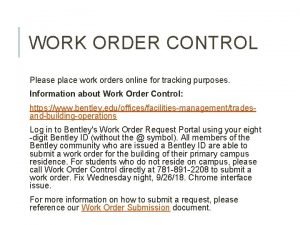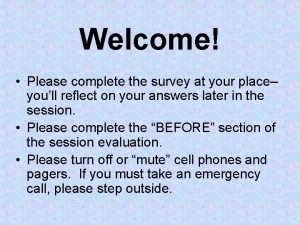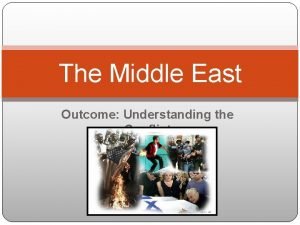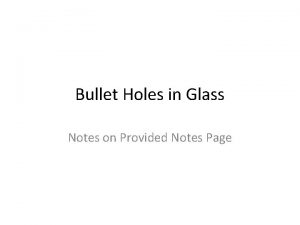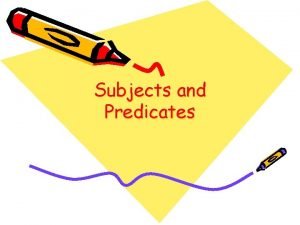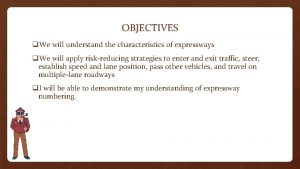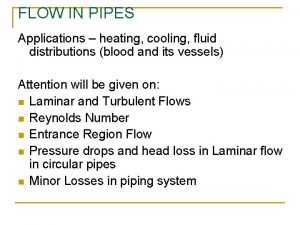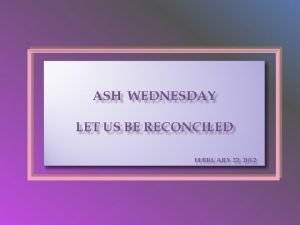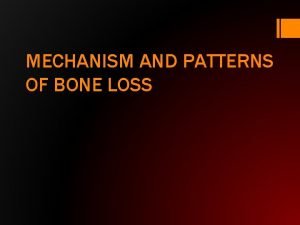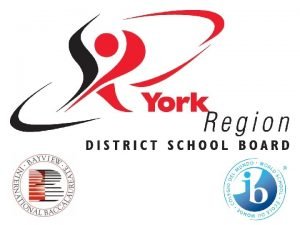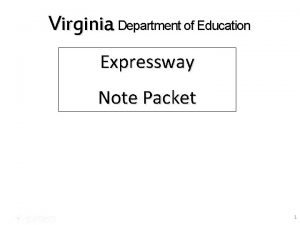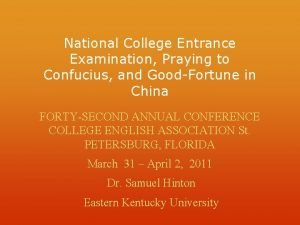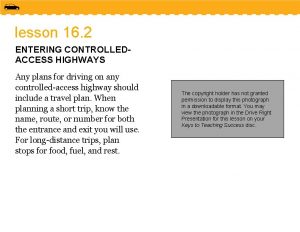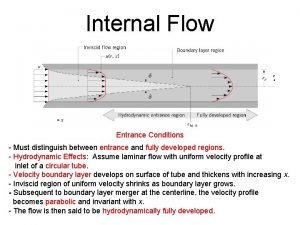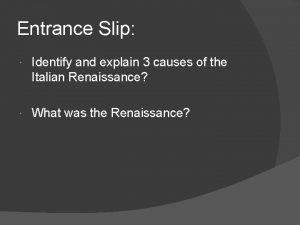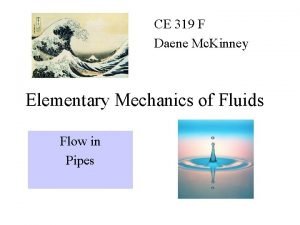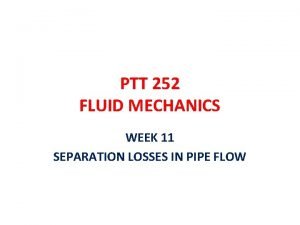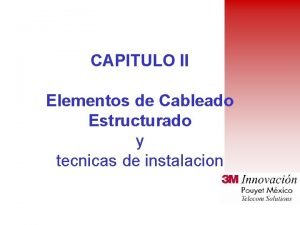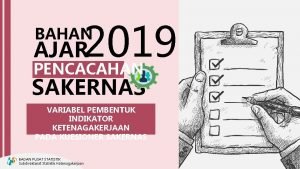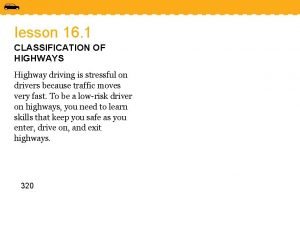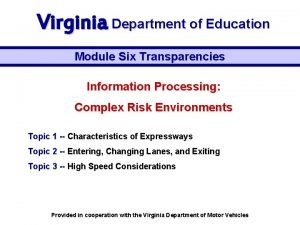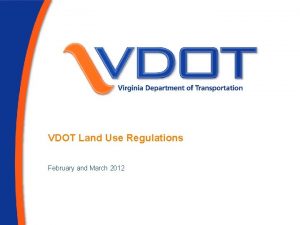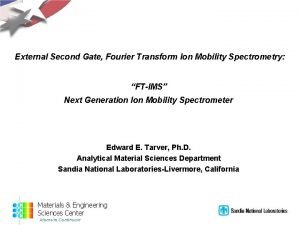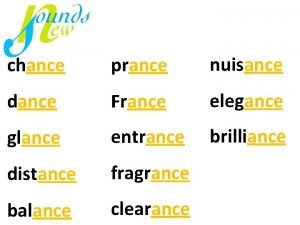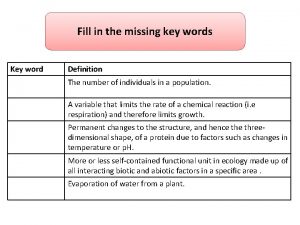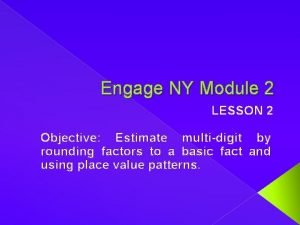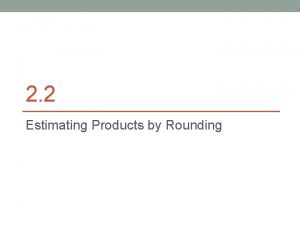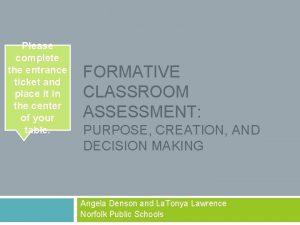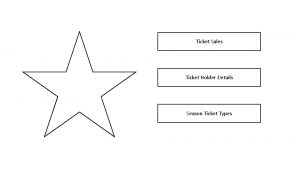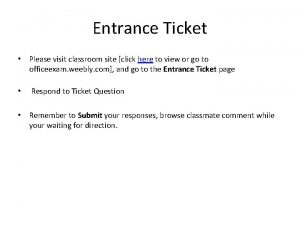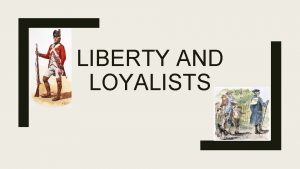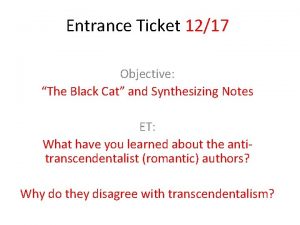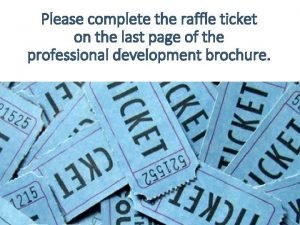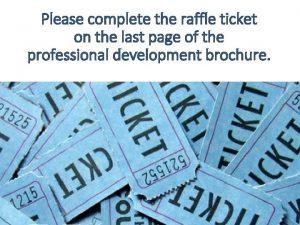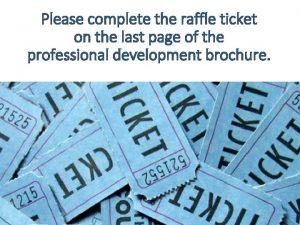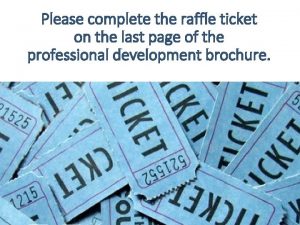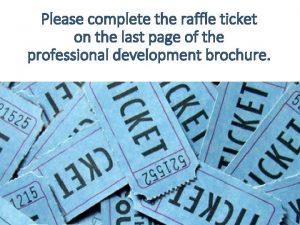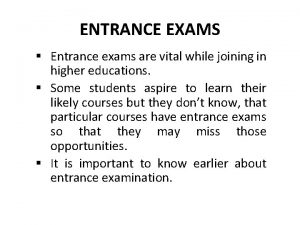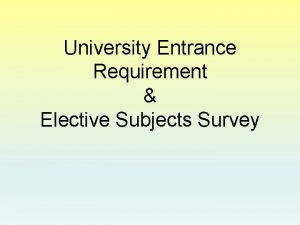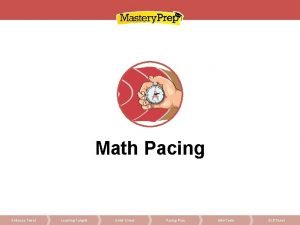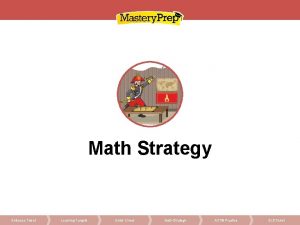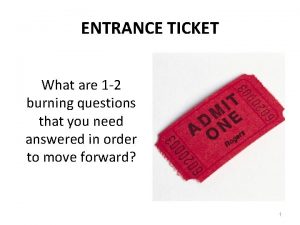Please complete the entrance ticket and place it



























































- Slides: 59

Please complete the entrance ticket and place it in the center of your table. FORMATIVE CLASSROOM ASSESSMENT: PURPOSE, CREATION, AND DECISION MAKING Angela Denson and La. Tonya Lawrence Norfolk Public Schools

Agenda ü ü ü Introduction and Objective Assessing Students What’s the Difference? Summative, Common Formative, and Formative Classroom Assessments Five Key Strategies of Formative Classroom Assessment Sample Formative Classroom Assessments Reflections

Schedule a 9: 00 Appointment

Assessing Students Anticipation Guide Ø Examples, Turn & Talk Ø

Instructional Changes

Concept Sort Types of Assessments

Summative Assessments • • • a final measure of how • students performed on multiple standards • taught over a period of • time usually given annually state/district created assessment OF learning high stakes can be a tool to evaluate the effectiveness of the instructional program

Common Formative Assessments used to: diagnose student learning difficulties, set individual teacher goals as well as team goals for student improvement, identify and share effective teaching strategies, plan differentiation • given bi-weekly or monthly • assessment FOR learning • may include formal pre-/post assessments to compare student growth •

Common Formative Assessments • • • similar in design and format to district and state assessments data is used to drive instruction writing samples

Common Formative Assessments “Not standardized tests, but rather teachercreated, teacher owned assessments that are collaboratively scored and that provide immediate feedback to students and teachers. ” Doug Reeves

Common Formative Assessments Cycle

Formative Classroom Assessments • • ongoing/daily used to gauge student progress during instruction and again at its conclusion helps teachers adjust teaching and learning as it happens and determine the next steps assessment FOR learning exit/entrance ticket think-pair-share white board responses graphic organizers

Formative Classroom Assessments • • • observations questioning gives students specific, descriptive feedback typically not used to assign grades data is used to drive/modify instruction

Formative Classroom Assessment Cycle Data Formative Assessment Cycle: Using Data Dayto-Day Data

Assessment and Instruction Formative assessment is a process used by teachers and students during instruction that provides feedback to adjust ongoing teaching and learning to improve students’ achievement of intended instructional outcomes. -CCSSO Formative Classroom Assessments

Why Assess Students? 16 *To certify achievement* the “end result” of the learning process reported by grade or standardized test Summative Assessment To compare or evaluate curriculum, schools, teachers, and/or students Accountability *To inform teaching and learning* gathered during the learning process, and allows teachers to make choices about instruction. Formative Assessment

Five Strategies of Formative Classroom Assessment (FCA) Strategy #1 - Clarifying, sharing, and understanding learning intentions and success criteria. Ø Ø Ø Design educational experiences backward from the intended outcome – If you don’t know where you’re going, you might end up somewhere else Specify learning intentions, but keep the context of learning out of the learning intention – begin lessons with an engaging question Differentiate success criteria (what we use to judge whether or not activities were successful)

Five Strategies of FCA Strategy #2 - Engineering Effective Discussion, Tasks, and Activities That Might Elicit Evidence of Learning Ø Ø No hands up, except to ask a question – having students raise their hands to show they have an answer is ineffective, the teacher should ask a question then randomly select a student to respond Plan questions prior to the lesson; allow think time (at least 3 seconds) after the question is posed answered; encourage students to give an answer and an explanation Try to have students construct responses rather than selecting them Provide corrective feedback

Five Strategies of FCA Strategy #2 (continued) All student response - at least every 20 minutes of group instruction Choose the assessment method Ø Letter/Number Cards that best matches the question. Ø Finger Voting Ø Colored Cards (red & green) and a magic bridge; identifying correct sentence structure, matching a sentence with a picture; cause & effect relationship; story details; three facts and a fib Ø Dry Erase Boards Ø Page Protectors (ex. graphic organizers) Ø Entrance/Exit Tickets

Five Strategies of FCA Strategy #2 (continued) Ø Question shells/stems: ~Questions asked affect the level of thinking ~1 hour a student spends devising questions about what they have been learning with correct solutions is more effective than one hour spent completing practice tests cried Carla ran into the house. fell

Sample Formative Assessment Stand Alone Format - Excellent Quick Assessment Adapted from VDOE

QUESTION STEM OR GRAPHIC ORGANIZER STEM Identify the facts and opinions of the passage or excerpt.

QUESTION STEMS - MAKING PREDICTIONS Adapted from VDOE

QUESTION STEMS - DRAWING CONCLUSIONS Adapted from VDOE

QUESTION STEMSSUMMARIZING Adapted from VDOE

FCA – Strategy #2 (Continued)

FCA – Strategy #2 (Continued)

Five Strategies of FCA Strategy #3 - Providing Feedback That Moves Learning Forward Ø Purpose – positive, corrective reinforcement to get the learner back on track during the learning process Ø When providing feedback, focus more on the reactions of the students and less on the feedback. Reactions include: ~a change in behavior (increase/reduce effort) ~a change in the goal (reduce/increase aspiration) ~abandonment of the goal (goal is too easy/hard) ~rejecting the feedback

Five Strategies of FCA Strategy #3 (Continued) Feedback vs. Feedbad

Five Strategies of FCA Strategy #3 (Continued) Feedback Feedbad paraphrasing error Add details to the 2 nd sentence to help your reader understand your focus Reread p. 19 then rewrite Confused with 2 nd sentence your comprehension answer Excellent job using word Use a dictionary cues to figure out a word

Five Strategies of FCA Strategy #3

Five Strategies of FCA Strategy #4 – Activating Students as Learning Resources for One Another Ø Purpose – engaging students in assessing the work of their peers can substantially increase student achievement Ø Cooperative Learning – when students work cooperatively to accomplish shared learning goals Ø Five conditions important in maximizing the likelihood that cooperative learning increases student achievement: (1) positive interdependence, (2) face-to-face interaction, (3) individual accountability, (4) frequent use of the relevant interpersonal, and small-group skills, (5) reflection time on learning

Five Strategies of FCA Strategy #5 – Activating Students as Owners of Their Own Learning (Self-Assessment) Ø Plus-Minus-Interesting: at the completion of an assignment, students identify one thing they found easy, difficult, and interesting about a task (respond on sticky notes, post, and review) Ø Learning Portfolios Ø Question Parking Lot Ø Learning Logs

Five Strategies of FCA Ø Ø Ø Ø Strategy #5 Students as Owners of Their Own Learning Model Expectations Looks Like Sounds Like Feels Like Review them frequently (routines & procedures)

Five Strategies of FCA Ø Ø Ø Strategy #5 Anchor Chart (revisit expectations) Looks like students showing respect Sounds like lots of academic language Feels like an “I can do it attitude” Look fors

FCA Cycle – Before, During, After Before During After Find out what the students know Monitor and Reflect and adjust teaching plan next steps and learning

Marzano’s High Yield Strategies http: //www. palmbeachschools. org/qa/documents/Handout 5 -Marzano. High. Yield. Strategies. pdf Research-based strategies for increasing student achievement: 1. 2. 3. 4. 5. Identifying Similarities and Differences=45% Summarizing and Note-taking=34% Nonlinguistic Representations=27% Cooperative Learning=23% Setting Objectives and Providing Feedback=23% Adapted from the book: Classroom Instruction that Works: Research-based Strategies for Increasing Student Achievement, by Robert Marzano (2001)

Video – Thumbs Up/Down

Activities Your Book of Bugs – Grade 1/2 (www. wegivebooks. org) Superstar in Golf and Life – Grades 4/5

Creating engaging activities Please locate this 2 nd grade passage in your packet and pull out your activity “goodie bag”

Animals, Animals – Grade 2 Activity 2. 10 c use dictionaries, glossaries, and indices Which two words would appear on the same dictionary page as these guide words? pouch stripe 1 2 post 3 peddle 4 stick practic e

Animals, Animals – Grade 2 Activity SOL 2. 7 singular possessives Exit Ticket Name ______________ Read the sentences below. A giraffe’s spots are brown. Its neck is very long. It eats leaves from tall trees. It’s the tallest animal in the savanna. Circle two words that show possession.

Animals, Animals – Grade 2 This is the same question as the previous slide, but the format is different. Read the sentences below. A giraffe’s spots are brown. Its neck is very long. It eats leaves from tall trees. It’s the tallest animal in the savanna. Circle two words that show possession. 1. It’s 2. 3. giraffe’ eats s 4. Its 5. leaves

Wegivebooks. org – Grade 2 Activity Your Book of Bugs – page 13 SOL 2. 7 c Use knowledge of antonyms and synonyms Choose two synonyms for trap on 1. let go page 13? 2. free 3. shut in 4. catch 5. eat

Wegivebooks. org – Grade 2 Your Book of Bugs – page 13 This is the same question as the previous slide, but the format is different. SOL 2. 7 c Use knowledge of antonyms and synonyms Complete the chart. Synonym s let go Antonyms trap catch free shut in

Wegivebooks. org – Grade 2 Main Idea Example

Student Comprehension Book – 182 pages of practice! Sample Table of Contents

Student Comprehension Book

Video – Stop Light

Checking for Understanding Thinking Outside the Box ◦ ◦ ◦ ◦ Paraphrasing/Retelling Summarizing Exit cards – what are three things that you learned in class today? Stoplight Exit Ticket Read/write/pair/share Specific Graphic Organizers: Descriptive pattern, time sequence, process/cause-effect, etc. Response Cards/Dry Erase Boards/Hand Signals Think/pair/share

Your turn Ø Let’s give it a try Ø Group participants The Pony Express – Grade 4

Please complete the after section -Anticipation Guide Review


Reflections 54

Instructional Internet Resources - - Brunelle, L. (2014). Your Book of Bugs. Retrieved from: www. wegivebooks. org Marzano, R. (2001). Marzano’s (Nine) High Yield Instructional Strategies. Retrieved from: http: //www. palmbeachschools. org/qa/documents/Handout 5 Marzano. High. Yield. Strategies. pdf Ryan, C. Animals, Animals. Retrieved from: www. readinga-z. com - Anticipation Guide video: http: //www. readingrockets. org/strategies/anticipation_guide - Concept Sort video: http: //www. readingrockets. org/strategies/concept_sort - Thumbs up/down video: https: //www. teachingchannel. org/videos/assess-and-celebratelearning - Red, green, yellow light: https: //www. teachingchannel. org/videos/daily-lessonassessment

Bibliography - Ainsworth, L. & Viegut, D. (2006). Common Formative Assessments: How to Connect Standards-Based Instruction and Assessment. Thousand Oaks, CA: Corwin. - Dodge, J. (2009). 25 Quick Formative Assessments for a Differentiated Classroom Grades 3 -8. New York, NY: Scholastic. - Hattie, J. (2011). Visible Learning for Teachers: Maximizing Impact on Learning. New York, NY: Routledge. - Frey, N. & Fisher D. (2011). The Formative Assessment Action Plan: Practical Steps to More Successful Teaching and Learning. Alexandria, VA: ASCD.

Bibliography - Marzano, R. (2001). Classroom Instruction that Works: Research-based Strategies for Increasing Student Achievement. Alexandria, VA: ASCD - Policastro, M. (2016). Formative Assessment in the New Balanced Literacy Classroom. North Mankato, MN: Maupin House Publishing by Capstone Professional. - Research for Better Teaching. (2010). Studying Skillful Teaching: Using Data Day to Day (course handouts). Action, MA: Research for Better Teaching, pp. 149 -152. - Wiliam, D. & Siobhan, L. (2015). Embedding Formative Assessment: Practical Techniques for K-12 Classrooms. West Palm Beach, FL: The Learning Sciences International.

Disclaimer Reference within this presentation to any specific commercial or noncommercial product, process, or service by trade name, trademark, manufacturer or otherwise does not constitute or imply an endorsement, recommendation, or favoring by the Virginia Department of Education.

Keep in Touch!!! Ø Email us at: Ø Angela Denson Ø adenson@nps. k 12. va. us Ø La. Tonya Lawrence Ø llawrence@nps. k 12. va. us
 Nobody said anything raymond carver
Nobody said anything raymond carver Please place an order
Please place an order Millions billions trillions chart
Millions billions trillions chart Translate the sentences into spanish
Translate the sentences into spanish Please complete the survey
Please complete the survey Module 5 topic 1 intersections
Module 5 topic 1 intersections Entrance hidden by bricks and rubble
Entrance hidden by bricks and rubble Bullet holes through glass
Bullet holes through glass Unlimited xcaret xperience
Unlimited xcaret xperience Complete subject and predicate
Complete subject and predicate Transfer transfer
Transfer transfer A wave is a disturbance that transfers energy
A wave is a disturbance that transfers energy Radiographic darkroom layout
Radiographic darkroom layout Entrance là loại hoạt cảnh
Entrance là loại hoạt cảnh What are the three parts of an expressway entrance?
What are the three parts of an expressway entrance? Head loss formula for sudden contraction
Head loss formula for sudden contraction Entrance culvert
Entrance culvert Sediment traps construction
Sediment traps construction Entrance antiphon for today's mass
Entrance antiphon for today's mass Bulbous bone contours
Bulbous bone contours 2 wire video door entry system
2 wire video door entry system Eye clinic york hospital
Eye clinic york hospital Bayview secondary ib program
Bayview secondary ib program Acceleration lane
Acceleration lane An organization providing an entrance ramp to internet
An organization providing an entrance ramp to internet Yale placement exams
Yale placement exams Prayer before entrance exam
Prayer before entrance exam Empty space between traffic clusters
Empty space between traffic clusters Entrance length
Entrance length Entrance slip
Entrance slip Entrance hymn
Entrance hymn Pipe entrance loss coefficient
Pipe entrance loss coefficient Walt disney world main entrance
Walt disney world main entrance Inward projecting pipe entrance
Inward projecting pipe entrance Short prayer for meeting
Short prayer for meeting 1. the space between traffic clusters is called a(n)
1. the space between traffic clusters is called a(n) Entrance facility
Entrance facility New entrance sakernas
New entrance sakernas Latebra in egg
Latebra in egg Cutting tool used in bench grinding machine is known as mcq
Cutting tool used in bench grinding machine is known as mcq If a driver mistakenly entered the wrong entrance ramp
If a driver mistakenly entered the wrong entrance ramp Entrance to enlightenment painting
Entrance to enlightenment painting Electrical service entrance
Electrical service entrance The merging area of an entrance ramp is marked by
The merging area of an entrance ramp is marked by Vdot ssar
Vdot ssar Fourier entrance
Fourier entrance How many syllables in brilliance
How many syllables in brilliance Rvh atrium entrance
Rvh atrium entrance Algonquin entrance scholarships
Algonquin entrance scholarships Upton hall entrance exam papers
Upton hall entrance exam papers Complete the missing word to complete the three key words
Complete the missing word to complete the three key words Round the factors and estimate the products exit ticket
Round the factors and estimate the products exit ticket 456x42
456x42 Hát kết hợp bộ gõ cơ thể
Hát kết hợp bộ gõ cơ thể Lp html
Lp html Bổ thể
Bổ thể Tỉ lệ cơ thể trẻ em
Tỉ lệ cơ thể trẻ em Chó sói
Chó sói Chụp tư thế worms-breton
Chụp tư thế worms-breton Bài hát chúa yêu trần thế alleluia
Bài hát chúa yêu trần thế alleluia

